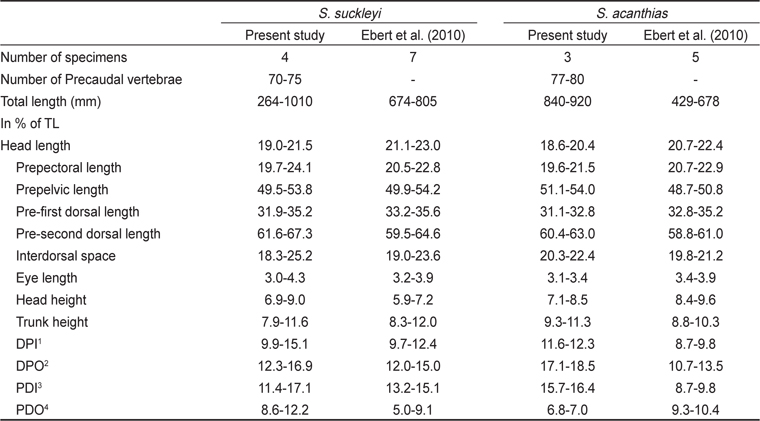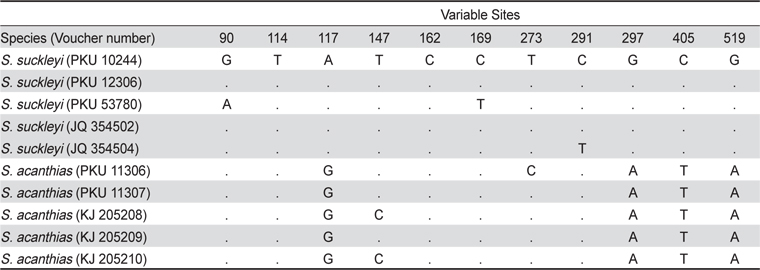돔발상어목(Squaliformes) 돔발상어과(Squalidae)에 속하는 돔발상어속(Squalus) 어류는 전세계적으로 25종(Ebert et al., 2013), 일본에 4종(Hatooka et al., 2013), 우리나라에 4종[곱상어, S. acanthias Linnaeus, 1758; 모조리상어, S. megalops (Macleay, 1881); 돔발상어, S. mitsukurii Jordan and Snyder, 1903; 도돔발상어, S. japonicas Ishikawa, 1908]이 보고되어 있다(Kim, 2011).
돔발상어속 어류는 콧구멍 덮개가 짧고, 등지느러미 앞 가장자리에 1개의 강한 가시를 가지며, 뒷지느러미가 없고, 꼬리자루 융기선과 미기각을 가지는 소형상어로 연안에 서식하며 작은 어류나 두족류, 갑각류 등을 먹는다(Kim et al., 2005) .
우리나라에서 곱상어는 Mori (1928)에 의해 최초 S. suckleyi로 보고되었으며 이후 Chyung (1961)도 곱상어의 학명으로 S. suckleyi를 사용하였다. 그러나, 곱상어의 학명이 American Fisheries Society (1960)에 의해 S. acanthias으로 기록된 이후부터는 대부분 S. acanthias만을 사용해 왔으며, 우리나라에서도 최근까지 이를 따랐다(Chyung, 1977; Kim et al., 2005; Kim, 2011).
Squalus acanthias는 최초 Linnaeus (1758)에 의해 유럽(모식산지: European Sea)에서 채집된 개체를 근거로 보고되었으며, S. suckleyi는 최초 Girard (1854)에 의해 미국 워싱턴주(동태평양)에서 채집된 개체를 근거로 보고되었다. 이후 두종은 외형상 매우 유사하여, 학자들간에 많은 의견 충돌을 보였다. S. suckleyi를 S. acanthias의 변종 또는 아종으로 간주하거나(Starks, 1917; Walford, 1935; Schultz, 1936; Clemens and Wilby, 1946), American Fisheries Society (1960), Compagno (1984) 이후에는 S. acanthias만이 곱상어의 타당한 학명으로 인정되었다. 그러나, 이후 Ward et al. (2007)은 S. acanthias를 분자수준에서 두 그룹으로 구분된다고 하였고, Ebert et al. (2010)도 Ward et al. (2007)의 두 그룹이 형태적으로도 잘 구분되므로 S. suckleyi를 부활시킬 것을 주장하였다. 현재 S. suckleyi는 북태평양에 분포하고, S. acanthias는 남태평양과 대서양에 분포하는 종으로 정리되었다(Ebert et al., 2013). 따라서 본 연구는 한국산 곱상어의 분류학적 위치를 명확히 하기 위해 뉴질랜드(남태평양)에서 채집된 S. acanthias와의 형태 및 분자 비교를 수행하였다.
2015년 흑산도 근해에서 채집된 곱상어 4개체와 2014년에 뉴질랜드에서 채집된 곱상어 3개체에 대하여 계수 및 계측형질을 조사하였다. 계측은 Compagno (2001)와 Last et al. (2007)의 방법을 따라 측정하였고, 꼬리지느러미 앞까지 척추골수는 X-ray (Sehwa Medical System SMS-CM, Korea)를 이용하여 계수하였다. 조사 후 표본은 부경대학교(Pukyoung National University, PKU)에 등록, 보관하였다.
Total DNA는 어체의 근육에서 Chelex 100 resin (Bio-rad, USA)을이용하여추출하였다. 미토콘드리아 DNA cytochrome c oxidase subunit I (COI)영역을 VF2와 FishR2 primer (Ward et al., 2005; Ivanova et al., 2007)로 증폭하였다. PCR 산물은 키트(Davinch-K CO. LTD., Korea)를 이용하여 정제하였다. 염기서열은 ABI Bigdye terminator cycle sequencing ready reaction kit v3.1 (Applied Biosystems)을 이용하여 판독하였다. 염기서열 정렬은 Clustal W (Thompson et al., 1994)의 BioEdit (ver. 7) (Hall, 1999)를 사용하였다. 염기서열 비교를 위해 NCBI에 등록된 북해산 S. acanthias 3개체, 동태평양에서 채집된 S. suckleyi 2개체와 외집단으로 돔발상어속의 도돔발상어(Squalus japonicus), 흉상어과의 무태상어(Carcharhinus brachyurus)의 염기서열을 수집하여 비교하였다. Neighbor-joining (NJ) tree (Saitou and Nei, 1987)는 Mega 5 (Tamura et al., 2011)의 Kimura two-parameter model (Kimura, 1980)을 이용하여 작성하였으며 bootstrap을 1,000번 수행하였다.
Squalus suckleyi (Girard, 1855) (국명: 곱상어) (Fig. 1)
Spinax suckleyi Girard, 1855: 196 (type locality: Fort Steilacomb, Puget Sound, Washington Territory, United States of America).
Squalus acanthias (not of Linnaeus): Jordan and Gilbert, 1881: 458; Bigelow and Schroeder, 1934: 17; Chyung, 1977: 83; Masuda et al., 1984: 9; Kim et al., 2005: 64; Kim, 2011: 11; Hatooka et el., 2013: 194.
Squalus suckleyi: Jordan and Hubbs; 1925: 105; Mori, 1928: 3; Fang and Wang, 1932: 246; Walford, 1935: 42; Clemens and Wilby 1946: 59; Mori, 1952: 22; Ebert et al., 2010: 28; Ebert et al., 2013: 95.
관찰표본: PKU 10244, 264 mm total length (TL), 제주도 제주시, 2014년 2월 24일; PKU 10309, 538 mm total length (TL), 전라남도 신안군, 2014년 3월 8일; 2014년 4월 2일; PKU 53779, 1010 mm TL, 전라남도 신안군, 2015년 2월 10일; PKU 53781, 770 mm TL, 전라남도 신안군, 2015년 2월 10일.
비교표본: PKU 11305-11307, 840-920 mm TL, 뉴질랜드, 2014년 9월 17일
기재: 계측값은 전장에 대한 백분율로 환산하여 Table 1에 나타내었다. 몸통은 방추형으로 가슴지느러미와 제1등지느러미 사이는 두터우며 꼬리지느러미 쪽으로 갈수록 가늘어진다(Fig. 1). 머리는 납작하며 주둥이는 비교적 좁고 뾰족한 삼각형에 가깝다. 입은 작고 눈은 옆으로 긴 타원형이며 순막이 없다. 이빨은 구부러진 칼날형태의 단첨두 형태의 이빨로 위턱은 2열, 아래턱은 1열로 배치되어 있으며 아래턱 이빨이 위턱 이빨보다 약간 크다. 새열은 5개이고, 분수공은 눈 후방에 가깝게 위치하며 크기는 안경 보다 약간 작다. 콧구멍은 좌우 1개씩 가지며 중앙에 콧구멍 덮개가 있어 2개처럼 보인다. 등지느러미는 2개로 잘 분리되어 있으며 각 등지느러미의 앞가장자리에는 강한 1개씩의 가시를 가진다. 제1등지느러미는 삼각형으로 상단이 약간 둥근 형태로 가슴지느러미 후단보다 약간 뒤에서 시작된다. 제2등지느러미는 삼각형으로 제1등지느러미보다 작고, 뒷지느러미 후단보다 약간 뒤에서 시작된다. 가슴지느러미의 폭은 넓지만 기저의 길이는 상대적으로 짧다. 배지느러미는 작고 끝부분이 약간 둥글다. 뒷지느러미는 없다. 꼬리자루부위가 비교적 가늘고 길며, 꼬리자루부위의 옆면에는 1개의 융기선이 나 있고 미기각이 있다. 꼬리지느러미는 상엽이 하엽보다 월등히 길다. 몸과 머리를 비롯하여 모든 지느러미가 방패비늘로 덮여 있다.
체색: 몸과 머리의 등쪽과 옆면은 회색, 배면은 흰색을 띤다. 등쪽에는 작은 흰색 반점들이 줄지어 나타난다. 제1등지느러미, 제2등지느러미, 꼬리지느러미 상엽은 끝 부분이 약간 검은색을 띠고, 가슴지느러미, 배지느러미, 꼬리지느러미 하엽의 끝부분은 흰색을 띤다.
분포: 우리나라 서해남부해역(본조사), 우리나라 전 해역(Kim et al., 2005), 북태평양, 미국, 러시아, 캐나다, 일본, 중국 등지에 분포한다(Ebert et al., 2013).
본 연구는 국내 서식하는 곱상어의 올바른 학명 사용을 위해 뉴질랜드산 곱상어와 형태 및 분자 비교를 수행하였으며, 그 결과 한국산 곱상어는 뉴질랜드산 곱상어(S. acanthias)와 형태(척추골수 등) 및 분자(mtDNA COI)에서 잘 구분되는 S. suckleyi인 것으로 확인되었다.
국내에서는 Mori (1928)가 곱상어를 S. suckleyi로 기재하였으나, S. suckleyi가 동종이명 처리된 이후 현재까지 곱상어는 S. acanthias로 기재되어 왔다(Chyung, 1977; Kim et al., 2005; Kim, 2011). 그러나 Ebert et al. (2010)은 S. suckleyi의 학명을 다시 부활시켰고 한국을 포함한 북태평양에 서식하는 곱상어는 모두 S. suckleyi라고 주장하였다. Ebert et al. (2010)은 S. suckleyi와 S. acanthias가 배지느러미 기저 중앙부터 제1등지느러미 기저 후단까지의 길이(PDI) (13.2-15.1% TL in S. suckleyi vs. 8.7-9.8% TL in S. acanthias) 및 배지느러미 기저 중앙부터 제2등지느러미 기점까지의 길이(PDO) (5.0-9.1% vs. 9.3-10.4%)에서 잘 구분된다고 제안하였다. 그러나, 본 연구 결과는 이전 결과와 약간 차이를 보였는데, 본 연구에서는 PDI (11.4-17.1% TL in S. suckleyi vs. 15.7-16.4% TL in S. acanthias)의 경우 종간 차이가 없었고, PDO (8.6-12.2% vs. 6.8-7.0%)는 Ebert et al. (2010)과 반대되는 결과를 보였다. 이러한 차이는 Ebert et al. (2010)의 연구에서 사용된 개체수가 S. suckleyi 7개체, S. acanthias 5개체로 적거나, S. suckleyi는 미국 워싱턴주(동태평양), S. acanthias는 미국 매사추세츠주(대서양) 및 호주 타즈매니아(남태평양)에서 채집된 개체를 사용하여 본 조사(뉴질랜드)와 멀리 떨어진 지역에서 채집된 표본을 대상으로 했기 때문으로 사료된다. 향후 보다 다양한 지역에서 더 많은 개체를 대상으로 면밀한 재검토가 필요하다고 생각된다. 본 연구에서는 S. suckleyi와 S. acanthias를 구분하는 계측 형질로 제1등지느러미 기저 중앙에서 배지느러미 기저 후단까지의 길이(DPO= 12.3-16.9 TL in S. suckleyi vs. 17.1-18.5 TL in S. acanthias), 배지느러미 기저 중앙에서 제2등지느러미 기저 후단까지의 길이(PDO= 8.6-12.2 TL in S. suckleyi vs. 6.8-7.0 TL in S. acanthias)로 확인되었다(Table 1). 한편, 꼬리지느러미 앞까지의 척추골수(한국산 S. suckleyi 70 - 75개 vs. 뉴질랜드산 S. acanthias 77 - 80개) (Table 1)는 Springer and Garric(1964)이 제시한 결과(북태평양산 S. suckleyi 68 - 76개 vs. 대서양 및 남태평양산 S. acanthias 75 - 85개)와 잘 일치하였다.
곱상어속 2종이 별종임을 증명하기 위하여 미토콘드리아 DNA COI영역 540bp의 염기서열을 비교 분석하였다. 그 결과, 한국산 S. suckleyi, 뉴질랜드산 S. acanthias는 각각 종내 0.0-0.4%, 0.0-0.2%의 낮은 유전 변이를 보였으나, S. suckleyi와 S. acanthias간의 유전 변이는 0.7-1.3%으로 종내 변이보다 큰 값을 보였다(Fig. 2). 특히, 540개 염기 중 117, 297, 405, 519번째의 4개 염기에서 두 종은 뚜렷이 구분되었다(Table 2). 동일속의 Squalus japonicus와 Squalus nasutus간의 유전거리가 0.6%인 점을 고려한다면 S. suckleyi와 S. acanthias 사이의 유전거리(0.7-1.3%)는 두종이 별종임을 지지해 준다. 나아가 Squalus 속 어류 15종의 COI영역을 비교한 결과, 종간 0.39-9.93%의 유전적 차이를 보이고(Ward et al., 2007), 연골어류는 경골어류와 달리 종간 유전 차이가 크지 않은 점(Martin and Palumbi, 1993) 등에서 두종은 충분히 별종으로 간주할 수 있다. 따라서 한국산 곱상어의 학명을 기존의 S. acanthias에서 S. suckleyi로 변경하고자 한다.









